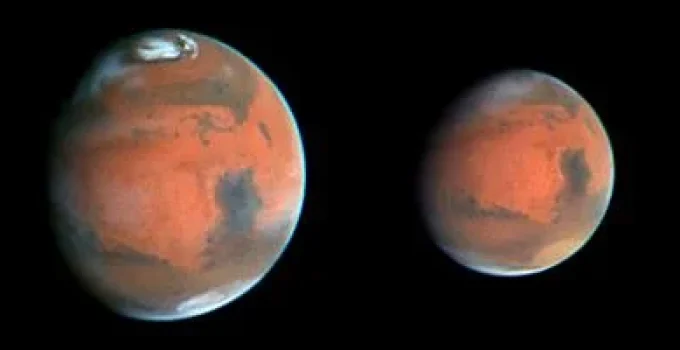Why Does Mars Look Red?
Answer:
Mars looks red because its surface is covered with iron-rich dust and rocks that have rusted over time. When iron reacts with oxygen, it forms iron oxide—the same thing that gives rust its reddish color. This rusty coating reflects sunlight in a way that makes the whole planet look red from space.
🚀 Dive Deeper
- What Makes Mars Look Red?
- Is Mars Really Red Up Close?
- What Is Martian Dust Made Of?
- Why Does This Matter to Scientists?
- Final Thoughts
- References
What Makes Mars Look Red?
The surface of Mars contains a lot of iron. Over millions of years, this iron mixed with tiny amounts of oxygen in the planet’s atmosphere. The result? Rust, or iron oxide, which gives the planet a reddish appearance.
Even though the whole planet isn’t red, this dusty, rusty coating spreads around the surface and into the atmosphere, making Mars look like a glowing red dot in the sky.
📊 Interesting Stat: Over 16% of Mars’ surface contains iron-rich minerals that can rust [1].
Is Mars Really Red Up Close?
Here’s the surprising part: Mars isn’t completely red up close! If you were standing on the surface, you’d see a mix of colors like butterscotch, gold, brown, and tan—with red dust in the air.
NASA rovers like Perseverance and Curiosity have sent back photos showing the real surface colors of Mars. The red look mostly comes from the fine dust in the air, which scatters sunlight and gives everything a red tint—kind of like how Earth’s sky turns orange during a sunset.
📊 Interesting Stat: Martian dust is so fine, it can float in the air for months and travel around the entire planet [2]!
What Is Martian Dust Made Of?

Photo: NASA/Dominic Hart
The dust on Mars is super fine and dry, made mostly of:
- Iron oxide (rust)
- Silicon dioxide (similar to sand)
- Magnesium and aluminum particles
This dust is easily picked up by the wind and can cause huge dust storms that cover the whole planet.
| Dust Component | What It Does |
|---|---|
| Iron oxide | Makes Mars look red |
| Silica (sand) | Adds texture and grit |
| Magnesium | Found in ancient volcanoes |
| Aluminum | Common in Martian rocks |
Because Mars has very low gravity and no rain, the dust doesn’t settle quickly and continues to swirl through the thin atmosphere.
📊 Interesting Stat: In 2018, a planet-wide dust storm lasted for months and blocked sunlight across Mars [3].
Why Does This Matter to Scientists?
The fact that Mars is red tells scientists a lot about the planet’s history. Here’s why it’s important:
- Past Water: Rust needs oxygen and water to form, so the presence of iron oxide suggests that Mars may have had liquid water billions of years ago.
- Atmosphere Clues: Studying the red dust helps scientists understand how Mars lost its atmosphere and became dry.
- Safe Exploration: Knowing what the dust is made of helps engineers build better rovers and space suits for future missions.
Mars’ reddish glow is more than just a pretty color—it’s a clue to the planet’s ancient past.
📊 Interesting Stat: Scientists believe Mars once had rivers, lakes, and even oceans, about 3 to 4 billion years ago [4].
🎯 Final Thoughts
So, why does Mars look red? It’s all because of iron-rich dust that has turned into rust over millions of years. This red dust covers the surface and floats in the atmosphere, giving Mars its famous nickname—the Red Planet. But if you were standing on Mars, you’d see a more colorful world than you might expect.
Mars continues to fascinate scientists and space lovers around the world. And the more we study that rusty red surface, the more we learn about the history of our solar system.
📚 References
- NASA Mars Exploration Program. “Why Is Mars Red?” https://mars.nasa.gov/resources/21615/why-is-mars-red
- NASA Earth Observatory. “Martian Dust Storms.” https://earthobservatory.nasa.gov/images/142401/a-dusty-view-of-mars
- NASA Jet Propulsion Laboratory. “Martian Dust Storm Wraps the Planet.” https://www.jpl.nasa.gov/news/martian-dust-storm-wraps-the-entire-planet
- Smithsonian Magazine. “Mars Once Had Oceans, Rivers and Lakes. Where Did the Water Go?” https://www.smithsonianmag.com/science-nature/mars-water-history-180976628
📌Learn More About the Solar System
- Why Don’t Planets Collide?🪐The Solar Systems Amazing Balance
- Which Planet Has the Most Moons?🪐Moon Madness In the Outer Solar System
- Why Do the Planets All Orbit the Sun?🪐The Cosmic Force Behind Their Paths
- Which Planet Could Humans Live On?🪐Searching for Our Second Home
- Which Planets Have Rings?🪐Saturn Is Not the Only Sky Princess
